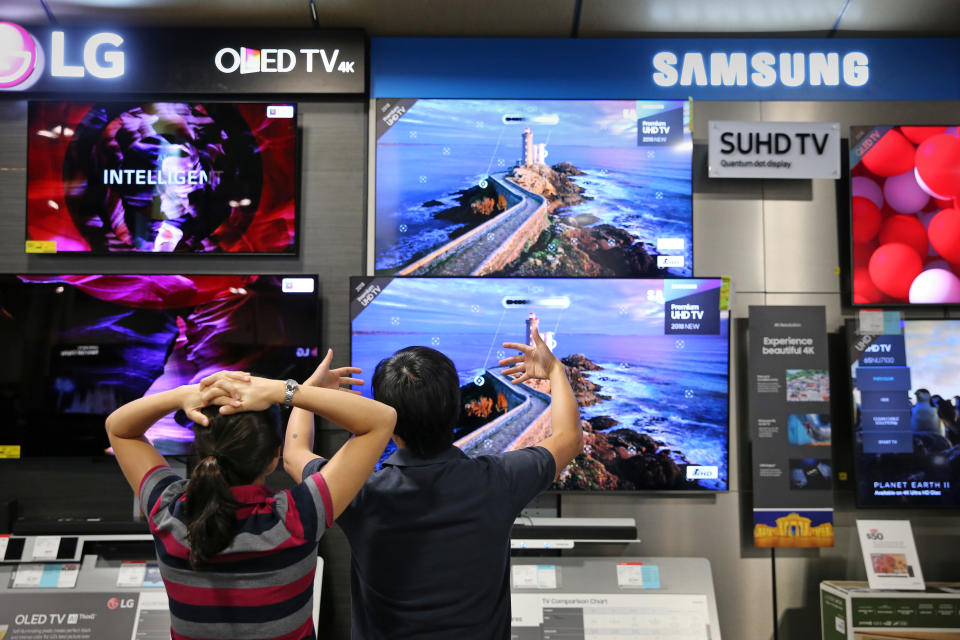How to shop for a new TV before the Super Bowl
It’s nearly that time of year. When you microwave too many pigs-in-a-blanket, toss back a few hot wings and wolf down a trough of chips and guac while the two best football teams in the NFL battle it out for the Vince Lombardi Trophy.
And if you’re the one hosting a Super Bowl party this year, you’re going to want to make sure that your guests have the best viewing experience possible. Unfortunately, your TV is probably old enough to get a driver’s license in most states.
But you don’t have to make your friends and family suffer by watching the game on your ancient monstrosity. Because now is the best time of year to score a deal on a brand-new big screen.
Before you throw down a wad of hundreds, though, check out these tips on what to avoid when shopping for a new TV.

Go big or go home
Look, your TV is going to last you a few years, so you’re going to want to make sure that when you plug it in and fire it up for the first time, you’re not left underwhelmed. Your best bet is to pick out the biggest TV for your home that you can comfortably see from your couch.
Don’t go overboard and buy an 80-inch set if it doesn’t fit in your living room, but if you’ve got the room and the cash, consider something about 50 inches or larger. If you want to get a 4K resolution panel, then you’ll want to go with a TV that’s 55 inches or bigger. Anything else, and you won’t really be able to tell the difference between 4K and 1080p since the pixels will be packed in so tightly.

Get a TV that supports HDR
There’s nothing wrong with opting for a 55-inch, 4K TV, but you’d be making a big mistake if you don’t opt for a set with high-dynamic range compatibility. HDR essentially enables your TV to display content with brighter, more vibrant colors and deeper, inkier blacks compared to standard-dynamic range. It also makes a heck of a bigger difference in terms of overall image quality versus making the jump from 1080p to 4K resolution.
But be careful. There are a number of HDR standards, with the main options being HDR10 and Dolby Vision. Other standards include HDR10+, a standard offered by Samsung; HLG, or hybrid-log gamma; and Technicolor HDR. If you can’t find a TV that supports all of those standards, and you likely won’t, you should be more than fine using HDR 10, which serves as the de facto industry-wide standard at the moment.
Avoid cash grabs
You might have heard that TV makers will soon begin selling 8K resolution televisions. That’s right, despite the fact that there isn’t enough 4K content available yet outside of a handful of video services and high-end gaming consoles, we’re jumping to TVs with even higher resolutions.
Needless to say, this isn’t a necessary step up. It’s simply a way for TV makers to get you interested in upgrading your 4K set faster than usual so they can pocket that sweet, sweet cash. In other words, don’t hold out for an 8K TV. Snag a 4K set instead.
In the same vein, you’ll want to avoid curved TVs. Yes, somehow these sets are still available. But don’t let that fact sway you. They’re still as pointless as they’ve always been. That’s because curved TVs make for poor viewing angles and are completely unnecessary.
They’re supposed to simulate a movie theater experience, but movie theater screens are only curved to make up for the extra distance light has to travel to reach the edges of projector panel versus the center. TVs don’t have such issues, so adding a curve is pointless.
Finally, don’t ever let a sales associate talk you into buying some ridiculously overpriced HDMI cable. If someone is trying to sell you on a cable that costs more than $20, put down the TV and walk away, because they’re really selling you the electronics version of snake oil. HDMI cables either work — or don’t. There’s no need to spend $100 on a cable. Ever.
More from Dan:
Here’s the unambiguous bright spot in Netflix’s disappointing earnings report
Daimler Trucks CEO says smart trucks will hit the road this year
Email Daniel Howley at dhowley@oath.com; follow him on Twitter at @DanielHowley. Follow Yahoo Finance on Facebook, Twitter, Instagram, and LinkedIn.finance.yahoo.com/


